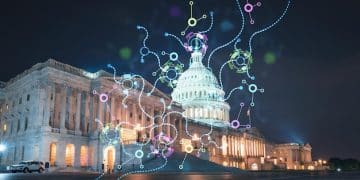Adapting Your Business Model to Thrive in 2025’s Evolving Consumer Landscape

Advertisements
Navigating the consumer landscape in 2025 demands businesses prioritize agility and customer-centricity, integrating technology, sustainability, and personalized experiences to meet evolving demands and secure market relevance.
Advertisements
The consumer landscape is in constant flux, shaped by technological advancements, shifting values, and unprecedented global events. Businesses aiming for sustained success must proactively evaluate and refine their strategies. Understanding How to Adapt Your Business Model to the Changing Consumer Landscape in 2025 is not merely an advantage; it is an imperative for remaining competitive and resonant with your target audience.
Advertisements
Understanding the Shifting Consumer Psychology
The modern consumer is evolving beyond simple transactions; they seek genuine connections, ethical practices, and personalized experiences. This shift in psychology means businesses must look beyond product or service offerings to truly understand what drives purchasing decisions and brand loyalty in 2025.
One profound change is the amplified focus on values. Consumers are increasingly aligning their spending with companies that reflect their social, environmental, and ethical stances. This isn’t just about PR; it’s about authentic integration of these values into the business model, from supply chain transparency to employee welfare.
The Rise of Conscious Consumption
Conscious consumption is no longer a niche trend; it’s a mainstream movement. Consumers are questioning the origins, impacts, and longevity of their purchases. This means:
- Sustainability as a Core Value: Businesses must demonstrate genuine commitment to environmental protection.
- Ethical Sourcing: Transparency in supply chains, fair labor practices, and cruelty-free production are non-negotiable.
- Longevity and Repairability: A move away from disposable culture towards products designed to last and be repaired.
Brands that neglect these aspects risk alienation and loss of market share. Authenticity is key; consumers are adept at detecting ‘greenwashing’ or performative social responsibility. Building trust requires consistent action and transparent communication.
Beyond values, there’s a heightened demand for personalization. Generic marketing and one-size-fits-all approaches are increasingly ineffective. Consumers expect brands to understand their individual needs, preferences, and even their emotional states, delivering tailored experiences across all touchpoints.
The digital native generations, now commanding significant purchasing power, also exhibit unique behaviors. Their comfort with technology translates into expectations for seamless digital interactions, rapid responses, and a pervasive online presence. Social media influence, peer reviews, and user-generated content hold sway, demanding a proactive and responsive online strategy from businesses.
Privacy Concerns and Data Trust
While personalization is desired, it must be balanced with growing privacy concerns. Consumers are more aware than ever of how their data is collected and used. Building trust in this digital age involves:
- Transparent Data Policies: Clearly articulating how data is used and protected.
- Giving Consumers Control: Allowing opt-outs and easy access to their data.
- Robust Security Measures: Protecting customer information from breaches.
A data breach can severely damage a brand’s reputation and consumer trust, highlighting the critical importance of a proactive and ethical data management strategy.
The overall shift points towards a more informed, empowered, and values-driven consumer. Businesses that succeed in 2025 will be those that deeply understand this evolving psychology and fundamentally recalibrate their models to serve these new expectations.
Embracing Digital Transformation and AI Integration
Digital transformation is no longer an option but a strategic imperative for businesses, especially as we look towards 2025. The integration of artificial intelligence (AI) across various facets of operations is poised to redefine efficiency, customer engagement, and decision-making capabilities. This goes beyond merely having an online presence; it involves a fundamental reimagination of business processes through digital lenses.
AI’s role in this transformation is multifaceted. From automating routine tasks to powering sophisticated analytics, AI can unlock new levels of productivity and insight. Businesses are leveraging AI for everything from predictive analytics in sales forecasting to optimizing supply chains, all contributing to a more agile and responsive operation.
AI-Powered Personalization and Customer Experience
One of the most impactful applications of AI in the consumer landscape is its ability to drive hyper-personalization. AI algorithms can analyze vast amounts of customer data—including purchase history, browsing behavior, and even emotional cues—to deliver highly tailored experiences. This could manifest as personalized product recommendations, customized marketing messages, or even dynamic pricing tailored to individual willingness to pay.
- Enhanced Customer Support: AI-powered chatbots and virtual assistants provide 24/7 support, answering common queries and escalating complex issues to human agents.
- Predictive Service: AI can anticipate customer needs and issues before they arise, allowing for proactive outreach and problem resolution.
- Content Customization: Dynamic website content and email campaigns that adapt in real-time to individual user preferences.
The key here is not just collecting data but effectively utilizing it to create meaningful and relevant interactions. A personalized experience fosters loyalty and can significantly increase conversion rates. However, it’s crucial to strike a balance between personalization and data privacy, respecting customer boundaries.
Beyond customer-facing applications, AI is revolutionizing internal operations. It streamlines workflows, reduces human error, and provides insights that were previously unattainable. For instance, AI in manufacturing can predict equipment failures, leading to proactive maintenance and minimized downtime. In finance, AI can detect fraudulent transactions with remarkable accuracy.
Operational Efficiency Through Automation
Automation, often powered by AI and machine learning, is transforming how businesses operate. Repetitive and time-consuming tasks can be offloaded to intelligent systems, freeing up human capital for more strategic and creative endeavors. This not only boosts efficiency but also enhances employee satisfaction by reducing mundane work.
- Robotic Process Automation (RPA): Automating data entry, invoice processing, and other administrative tasks.
- Inventory Management: AI-driven systems optimize stock levels, reducing waste and ensuring product availability.
- Quality Control: AI-powered vision systems can inspect products for defects with greater speed and accuracy than humans.
The strategic deployment of AI allows businesses to scale their operations without proportionally increasing labor costs, thereby improving profitability. However, successful AI integration requires significant investment in infrastructure, talent acquisition, and ongoing training to ensure employees can effectively collaborate with these new technologies.
Embracing digital transformation and AI integration means fostering a culture of innovation and continuous learning. Businesses must be willing to experiment, iterate, and adapt their strategies as technology evolves. Those that view AI not just as a tool but as a partner in strategic growth will be best positioned to thrive in the complex consumer landscape of 2025.
Building Authentic Connections and Community
In a world saturated with digital noise and fleeting trends, consumers are increasingly seeking authenticity and a sense of belonging. For businesses in 2025, building genuine connections and fostering a loyal community around their brand is paramount. This goes far beyond traditional marketing; it’s about cultivating relationships and creating an ecosystem where customers feel valued, heard, and part of something larger.
Authenticity starts with consistent brand messaging and values that resonate with the target audience. Consumers are adept at spotting performative actions; therefore, businesses must genuinely embody the principles they profess. This means everything from internal company culture to external marketing campaigns should reflect a coherent and sincere brand identity. When a brand’s actions align with its stated values, trust is built, which is the bedrock of strong customer relationships.
Engaging with Social Media Beyond Marketing
Social media platforms are no longer just broadcasting channels for promotional content. They are vibrant spaces for interaction, feedback, and community building. For businesses, this means:
- Active Listening: Monitoring conversations about your brand and industry to understand customer sentiment and emerging trends.
- Direct Engagement: Responding to comments, messages, and reviews promptly and empathetically.
- User-Generated Content: Encouraging and showcasing content created by your customers, which serves as powerful social proof.
The goal is to foster two-way conversations rather than one-way communications. By actively participating in communities relevant to their brand, businesses can humanize their presence and demonstrate that they value customer input. This collaborative approach can lead to valuable insights for product development, service improvements, and marketing strategies.
Creating opportunities for customers to connect with each other, not just with the brand, is also vital. Online forums, exclusive social groups, or even in-person events (when feasible) can transform individual customers into a collective community. This sense of shared identity and experience strengthens brand loyalty and advocacy.
Furthermore, transparency plays a significant role in building authentic connections. Admitting mistakes, being open about challenges, and sharing the brand’s journey can endear businesses to consumers who appreciate honesty. This vulnerability, when handled appropriately, can foster profound trust and respect, reinforcing the idea that the brand is human and relatable.

Emphasizing Customer Feedback Loops
A true commitment to customers means not just listening to feedback but actively integrating it into business processes. Establishing robust feedback loops allows businesses to continuously improve and demonstrate that customer opinions genuinely matter. This could involve:
- Surveys and Polls: Regularly collecting structured feedback on products, services, and overall experience.
- Customer Advisory Boards: Inviting loyal customers to provide input on future initiatives and strategies.
- Live Chat and Direct Messaging: Providing accessible channels for real-time customer support and spontaneous feedback.
When customers see their suggestions implemented or their concerns addressed, their sense of belonging and loyalty deepens. Negative feedback, when handled constructively, can be transformed into opportunities for improvement and often leads to an even stronger relationship. It’s not just about resolving issues but about showing genuine care.
Ultimately, in 2025, businesses that prioritize authentic connections and community building will cultivate not just customers, but advocates. These brand enthusiasts become powerful organic marketers, sharing their positive experiences and reinforcing the brand’s values within their networks. This human-centric approach is indispensable for long-term success in a competitive and rapidly changing market.
Prioritizing Sustainability and Ethical Practices
Sustainability and ethical practices are no longer mere corporate social responsibility buzzwords; they are fundamental pillars of modern business models, particularly as we approach 2025. Consumers, especially younger generations, are increasingly discerning and demand that the brands they support demonstrate genuine commitment to environmental stewardship and socially responsible operations. Businesses that fail to integrate these principles authentically risk losing relevance and market share.
The shift towards conscious consumption is driving this demand. Consumers are actively seeking out products and services that minimize environmental harm, support fair labor practices, and contribute positively to society. This requires businesses to look beyond superficial greenwashing and embed sustainability throughout their entire value chain, from sourcing raw materials to product disposal.
Circular Economy Principles
Moving away from a linear “take-make-dispose” model, businesses are increasingly adopting circular economy principles. This involves designing products with longevity, reusability, and recyclability in mind. Key aspects include:
- Product as a Service: Shifting from selling products to offering them as services, encouraging return and refurbishment (e.g., clothing rental).
- Waste Reduction: Minimizing waste across all operations, from manufacturing processes to packaging.
- Recycling and Upcycling: Creating systems for products or their components to be recovered and reintegrated into the production cycle.
Embracing circularity isn’t just about environmental responsibility; it can also lead to significant cost savings through reduced material consumption and waste management expenses. It also opens up new revenue streams through repair services, resale markets, and innovative product designs that leverage recycled content.
Beyond environmental impact, ethical practices encompass fair treatment of employees, responsible supply chain management, and community engagement. This includes ensuring fair wages, safe working conditions, and respect for human rights across all tiers of the supply chain, which can be particularly complex for global businesses. Transparency in these areas builds significant trust with consumers and other stakeholders.
Furthermore, diversity, equity, and inclusion (DEI) are integral components of ethical business practices. Companies are expected to foster inclusive workplaces and ensure their products and marketing efforts reflect the diverse societies they serve. A strong DEI commitment not only attracts and retains talent but also resonates with a broad customer base that values social justice.
Transparent Reporting and Verification
To demonstrate genuine commitment to sustainability and ethics, businesses must move beyond mere claims and engage in transparent reporting and third-party verification. This involves:
- Sustainability Reports: Publishing comprehensive data on environmental footprint, social impact, and governance practices.
- Certifications: Obtaining industry-recognized certifications (e.g., B Corp, Fair Trade, LEED) that validate ethical and sustainable claims.
- Supply Chain Audits: Conducting regular audits of suppliers to ensure adherence to ethical labor and environmental standards.
Such measures build credibility and allow consumers to make informed choices. The absence of transparent reporting or a reluctance to engage in external verification can lead to skepticism and erode consumer trust. Brands that proactively share their sustainability journey, including challenges and progress, tend to build stronger, more authentic connections with their audience.
Ultimately, prioritizing sustainability and ethical practices means integrating them into the core business strategy, not treating them as an add-on. It requires leadership commitment, investment in green technologies, and continuous improvement. In 2025, businesses that champion these values will not only attract conscious consumers but also foster resilience and innovation within their own operations, securing a more sustainable future for all.
Agility and Resilience in Business Operations
The turbulent landscape of recent years has unequivocally demonstrated that business stability is a myth. For 2025, agility and resilience are not just desirable traits; they are fundamental prerequisites for survival and growth. This means developing the capacity to quickly adapt to market shifts, technological advancements, and unforeseen global disruptions, alongside building robust systems that can withstand shocks rather than crumble under pressure.
Agility in operations refers to a business’s ability to pivot strategies, reallocate resources, and introduce new products or services with speed and efficiency. This requires flexible organizational structures, decentralized decision-making, and a culture that embraces change and experimentation rather than resisting it. It’s about being proactive in anticipating change, rather than merely reacting to it.
Flexible Organizational Structures
Traditional hierarchical structures can often impede agility by slowing down communication and decision-making. To foster greater responsiveness, businesses should consider:
- Cross-functional Teams: Breaking down silos to allow diverse teams to collaborate on projects, promoting faster problem-solving.
- Empowered Employees: Granting more autonomy to employees closest to the customer or problem, enabling quicker responses.
- Iterative Development: Adopting methodologies like Agile and Lean to bring products or improvements to market faster through continuous cycles of feedback and refinement.
This organizational flexibility allows businesses to quickly reconfigure their assets and human capital to address emerging opportunities or threats. It also encourages a distributed leadership model, which can be particularly effective in rapidly changing environments where centralized control might be too slow.
Resilience, on the other hand, is about a business’s capacity to absorb disruptions and recover effectively. This involves building redundancies, diversifying supply chains, and having robust contingency plans in place. The goal is to minimize the impact of adverse events and ensure business continuity, even in the face of significant challenges.
Diversified Supply Chains and Risk Management
The vulnerabilities exposed by global events have underscored the critical need for resilient supply chains. Relying on a single source or a limited geographic region can pose immense risks. Diversification strategies include:
- Multi-Sourcing: Engaging multiple suppliers for critical components or services to reduce dependency on one.
- Geographic Spreading: Sourcing from various regions to mitigate risks associated with localized disruptions (e.g., natural disasters, geopolitical tensions).
- Buffer Stock and Inventory Optimization: Maintaining strategic levels of inventory for essential items without incurring excessive holding costs.
Beyond diversification, proactive risk management involves identifying potential threats, assessing their likelihood and impact, and developing mitigation strategies. This could range from cybersecurity protocols to financial hedging strategies, ensuring that the business is prepared for a wide array of potential disruptions. Regularly reviewing and updating these plans is crucial, as the risk landscape is constantly evolving.

Ultimately, businesses that thrive in 2025 will be those that integrate agility and resilience into their core DNA. This means fostering a culture of continuous learning, embracing technological solutions for dynamic forecasting and operational visibility, and making strategic investments in infrastructure that supports rapid adaptation. The ability to pivot quickly and recover strongly will be the defining characteristic of successful enterprises in the coming years.
Leveraging Data Analytics for Strategic Insights
In the evolving consumer landscape of 2025, data is the new currency, and the ability to effectively collect, analyze, and interpret it is a significant competitive advantage. Businesses are moving beyond basic reporting to harness advanced data analytics for strategic insights, driving informed decision-making and fostering proactive adaptation. This involves transforming raw data into actionable intelligence that can predict trends, optimize operations, and enhance customer experiences.
The sheer volume of data available from digital interactions, IoT devices, and traditional sources is immense. The challenge lies not just in collecting this data but in extracting meaningful patterns and predictions from it. Advanced analytics tools, powered by machine learning and AI, are crucial for this process, enabling businesses to uncover insights that might otherwise remain hidden.
Predictive Analytics for Consumer Behavior
One of the most powerful applications of data analytics is its ability to predict future consumer behavior. By analyzing historical data and identifying correlations, businesses can anticipate customer needs, preferences, and purchasing patterns. This allows for:
- Tailored Product Development: Developing new products or features based on predicted demand and preferences.
- Optimized Marketing Campaigns: Targeting specific customer segments with highly relevant messages at opportune times.
- Demand Forecasting: Predicting sales volumes to optimize inventory, production, and staffing levels, reducing waste and improving efficiency.
Predictive analytics also extends to understanding customer churn—identifying customers at risk of leaving and implementing proactive retention strategies. By understanding why customers might leave, businesses can intervene with personalized offers or improved services before it’s too late. The insights gained from these analyses provide a tangible edge in a competitive market, allowing for proactive, rather than reactive, strategies.
Beyond customer behavior, data analytics is vital for optimizing internal operations. From supply chain efficiency to employee performance, data can reveal bottlenecks, identify areas for improvement, and inform strategic resource allocation. Real-time dashboards and reporting tools provide a continuous pulse on the business, enabling quick interventions and adjustments.
Moreover, the ethical implications of data collection and usage are becoming increasingly prominent. Businesses must not only comply with data privacy regulations but also build trust with consumers by being transparent about their data practices. Misuse or mishandling of data can severely damage a brand’s reputation and lead to significant financial penalties.
Measuring ROI of Adaptation Strategies
As businesses invest in adapting their models, data analytics provides the tools to measure the return on investment (ROI) of these changes. By setting clear metrics and tracking performance over time, businesses can assess the effectiveness of new initiatives and refine their strategies as needed. Key metrics might include:
- Customer Acquisition Cost (CAC): Measuring the cost of acquiring new customers after implementing new marketing approaches.
- Customer Lifetime Value (CLV): Assessing the long-term value of customers through improved engagement and retention efforts.
- Operational Cost Reductions: Quantifying savings achieved through automation or process optimizations.
Without robust data analytics, businesses would be operating on intuition, making it difficult to justify investments or identify true success. Data-driven decision-making ensures that adaptation efforts are not only effective but also financially sound, providing a clear path to sustainable growth and profitability in the dynamic consumer landscape of 2025.
Future-Proofing Through Continuous Innovation
In the relentlessly evolving consumer landscape of 2025, the concept of “future-proofing” a business is less about static protection and more about dynamic, continuous innovation. It’s about instilling a culture where experimentation, learning, and adaptation are embedded into the DNA of the organization. Stagnation is a direct path to obsolescence, emphasizing the necessity for businesses to always be looking forward, anticipating the next wave of change, and actively shaping their own future.
Innovation extends beyond just new products or services; it encompasses process improvements, business model alterations, and new ways of engaging with customers. It requires a willingness to challenge assumptions, embrace new technologies, and even disrupt one’s own existing successful models before external forces do. This proactive stance is what differentiates leaders from followers in a rapidly changing market.
Fostering an Experimental Mindset
A key component of continuous innovation is fostering an experimental mindset throughout the organization. This means creating an environment where:
- Failure is a Learning Opportunity: Encouraging employees to try new things and view setbacks as valuable lessons rather than punitive events.
- Cross-Departmental Collaboration: Breaking down silos to stimulate the exchange of ideas and diverse perspectives.
- Dedicated Innovation Budgets: Allocating resources specifically for R&D, pilot projects, and exploring emerging technologies.
This mindset encourages employees at all levels to identify opportunities for improvement and innovation, leading to a steady stream of new ideas. It also cultivates a culture of agility, allowing businesses to test new concepts quickly, gather feedback, and iterate, rather than investing heavily in initiatives that might not resonate with the market.
Beyond internal initiatives, continuous innovation also involves external scanning—monitoring competitive landscapes, technological breakthroughs, and shifts in consumer behavior globally. This external awareness allows businesses to identify emerging trends early and adapt their strategies accordingly, staying ahead of potential disruptions.
Investing in skill development and talent acquisition is also critical. As new technologies and methodologies emerge, the workforce needs to evolve. Continuous learning programs, external training, and recruiting individuals with diverse skill sets ensure that the business has the human capital required to drive innovation. This includes expertise in areas like AI, data science, and sustainable design, which are increasingly vital.
Strategic Partnerships and Ecosystem Building
No single business can innovate in isolation across all fronts. Strategic partnerships and participation in broader industry ecosystems are becoming increasingly important for future-proofing. This means:
- Collaborating with Startups: Partnering with agile startups for access to cutting-edge technologies or disruptive business models.
- University Research Collaborations: Engaging with academic institutions to tap into advanced research and talent pools.
- Industry Alliances: Joining forces with other companies to address common challenges, share resources, or set new industry standards.
By building a robust network of partners, businesses can extend their capabilities, diversify their risk, and gain a broader perspective on market dynamics. This collaborative approach to innovation accelerates the development of new solutions and helps businesses navigate complex challenges more effectively.
Ultimately, future-proofing through continuous innovation is about nurturing a dynamic and adaptive organization. It’s about being perpetually in motion, learning from every experience, and proactively shaping one’s destiny rather than passively reacting to external forces. For a business to thrive in 2025 and beyond, innovation must be a constant journey, not a destination.
| Key Adaptation Area | Brief Description |
|---|---|
| 🎯 Consumer Psychology | Meeting evolving demands for values, personalization, and digital seamlessness. |
| 🤖 Digital & AI Integration | Leveraging AI for personalization, efficiency, and data-driven insights. |
| 🌱 Sustainability & Ethics | Embedding circularity, fair practices, and transparency throughout operations. |
| 🚀 Agility & Innovation | Fostering flexibility, resilience, and a continuous experimental mindset. |
Frequently Asked Questions
▼
Adapting business models is crucial for 2025 due to rapid shifts in consumer behavior, technological advancements like AI, and increased demands for sustainability and ethical practices. Businesses that remain static risk losing market relevance, customer loyalty, and competitive edge to more agile and forward-thinking competitors who proactively meet these evolving expectations.
▼
AI contributes significantly by enabling hyper-personalization of customer experiences, automating operational tasks for increased efficiency, and providing predictive analytics for strategic decision-making. It allows businesses to understand customer needs better, optimize resource allocation, and anticipate market trends, fostering a more responsive and data-driven approach to adaptation.
▼
Sustainability is no longer optional; it’s a core consumer expectation. Businesses must integrate eco-friendly practices across their supply chains, embrace circular economy principles, and ensure ethical labor practices. This not only builds consumer trust and loyalty but also opens new revenue streams, reduces waste, and enhances brand reputation, aligning with conscious consumer values.
▼
Building genuine connections involves moving beyond transactional relationships to foster community and trust. This includes authentic transparency in brand values, active engagement on social media platforms, encouraging user-generated content, and implementing robust customer feedback loops. Listening to and valuing customer input creates a sense of belonging and strengthens brand loyalty.
▼
“Agility” refers to a business’s ability to quickly pivot strategies, reallocate resources, and innovate in response to market changes. “Resilience” is the capacity to withstand and recover from disruptions, such as supply chain issues or economic downturns. Together, they form a robust operational foundation allowing businesses to not just survive but thrive amidst constant change.
Conclusion
The journey toward 2025 presents both challenges and unparalleled opportunities for businesses willing to evolve. Adapting your business model to the changing consumer landscape demands a holistic approach, intertwining technological prowess, ethical commitment, and a deep understanding of human behavior. By prioritizing agility, embracing digital transformation, championing sustainability, fostering authentic connections, and leveraging data for insight, businesses can not only navigate the complexities of this new era but also forge stronger, more resilient paths to success. The future belongs to those who are not afraid to innovate and continuously redefine what it means to serve their evolving clientele.





